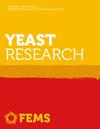QTL mapping reveals novel genes and mechanisms underlying variations in H2S production during alcoholic fermentation in Saccharomyces cerevisiae
IF 2.7
4区 生物学
Q3 BIOTECHNOLOGY & APPLIED MICROBIOLOGY
引用次数: 0
Abstract
Saccharomyces cerevisiae requirement for reduced sulfur to synthesise methionine and cysteine during alcoholic fermentation, is mainly fulfilled through the sulfur assimilation pathway. S. cerevisiae reduces sulfate into sulfur dioxide (SO2) and sulfide (H2S), whose overproduction is a major issue in winemaking, due to its negative impact on wine aroma. The amount of H2S produced is highly strain-specific and also depends on SO2 concentration, often added to grape must. Applying a Bulk Segregant Analysis to a 96 strain-progeny derived from two strains with different abilities to produce H2S, and comparing allelic frequencies along the genome of pools of segregants producing contrasting H2S quantities, we identified two causative regions involved in H2S production in the presence of SO2. A functional genetic analysis allowed the identification of variants in four genes able to impact H2S formation, viz; ZWF1, ZRT2, SNR2 and YLR125W, and involved in functions and pathways not associated with sulfur metabolism until now. These data point out that, in wine fermentation conditions, redox status and zinc homeostasis are linked to H2S formation while providing new insights into the regulation of H2S production, and a new vision of the interplay between the sulfur assimilation pathway and cell metabolism.QTL 图谱揭示了酿酒酵母在酒精发酵过程中产生 H2S 的新基因和新机制
酿酒酵母(Saccharomyces cerevisiae)在酒精发酵过程中需要还原硫来合成蛋氨酸和半胱氨酸,这主要是通过硫同化途径来实现的。葡萄酿酒酵母将硫酸盐还原成二氧化硫(SO2)和硫化物(H2S),由于其对葡萄酒香气的负面影响,过量产生硫化物是酿酒过程中的一个主要问题。H2S 的产生量因菌株而异,也取决于二氧化硫的浓度,通常会添加到葡萄汁中。通过对产生 H2S 能力不同的两个菌株所产生的 96 个菌株后代进行大量分离分析,并比较产生 H2S 数量截然不同的分离株基因组的等位基因频率,我们确定了在 SO2 存在的情况下产生 H2S 的两个致病区域。通过功能基因分析,我们发现了四个能够影响 H2S 形成的基因变异,即 ZWF1、ZRT2、SNR2 和 YLR125W,它们参与了迄今为止与硫代谢无关的功能和途径。这些数据表明,在葡萄酒发酵条件下,氧化还原状态和锌平衡与 H2S 的形成有关,同时为 H2S 生成的调控提供了新的见解,并为硫同化途径与细胞代谢之间的相互作用提供了新的视角。
本文章由计算机程序翻译,如有差异,请以英文原文为准。
求助全文
约1分钟内获得全文
求助全文
来源期刊

FEMS yeast research
生物-生物工程与应用微生物
CiteScore
5.70
自引率
6.20%
发文量
54
审稿时长
1 months
期刊介绍:
FEMS Yeast Research offers efficient publication of high-quality original Research Articles, Mini-reviews, Letters to the Editor, Perspectives and Commentaries that express current opinions. The journal will select for publication only those manuscripts deemed to be of major relevance to the field and generally will not consider articles that are largely descriptive without insights on underlying mechanism or biology. Submissions on any yeast species are welcome provided they report results within the scope outlined below and are of significance to the yeast field.
 求助内容:
求助内容: 应助结果提醒方式:
应助结果提醒方式:


